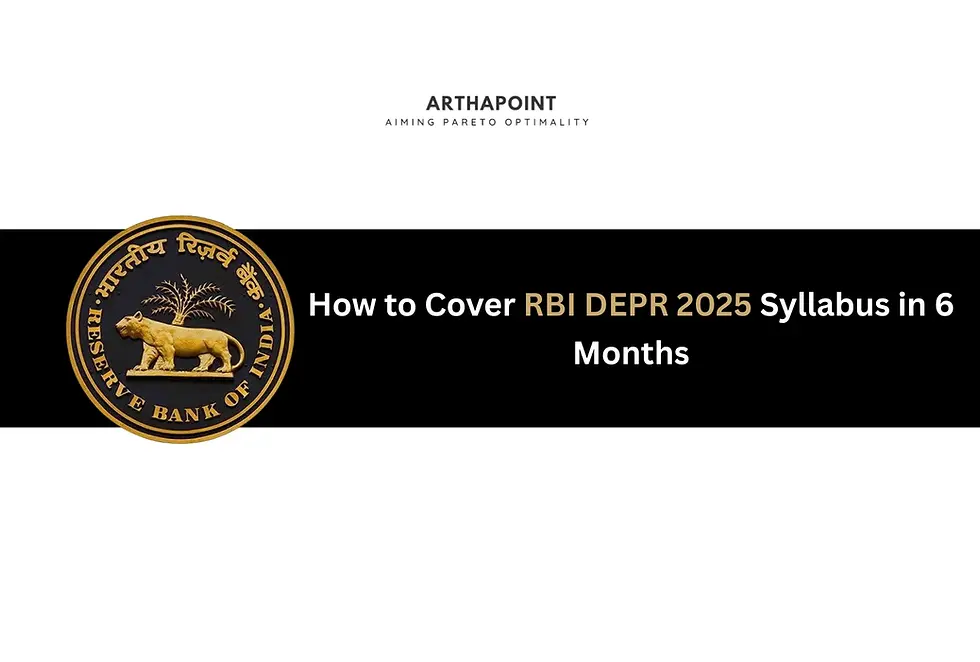RBI Grade B DEPR 2025 Syllabus – what’s really changed?
- ArthaPoint
- Sep 15
- 3 min read
If you’re aiming at RBI’s Grade B DEPR this year, stop for a second. Are you sure you’re studying from the right blueprint? Because the RBI Grade B DEPR Syllabus for 2025 looks familiar but there are a few quiet changes hidden in plain sight. Let’s open it up and see.
Why the syllabus matters more than you think
Think of it as your GPS. Without it you’re wandering.
RBI likes to tweak topics to mirror new economic debates.
People who spot the changes early start smarter.
Knowing where the marks are hiding saves you time.
It’s easier to win a game when you know the rules, right?
When you know exactly what’s on the table, you also know what you can safely ignore. That alone can shave weeks off your prep.
Phase I – your first checkpoint
Paper 1: Economics (objective). Paper 2: English (descriptive). This is about speed, basics and keeping your head clear.
Things still on the menu in 2025:
Microeconomics – demand, production, pricing, welfare.
Macroeconomics – employment, output, inflation, monetary, IS–LM, schools of thought.
International economics – trade theories, balance of payments, exchange rates.
Growth and development – classical and modern models.
Public finance – taxation, expenditure, debt.
Environmental economics – Green GDP, valuation, policy tools.
Quantitative methods – maths, stats, regression.
Indian economy updates – growth, inflation, unemployment, external sector, agriculture, industry, services.
Pause for a moment: which bullet above gives you that sinking feeling? Many candidates lose marks in exactly that one weak area.
Phase II – the real test
Descriptive, slower, deeper. You have to think, structure, and explain. This is where knowledge and expression meet.
Paper 1 – Economics
Microeconomic analysis
Consumer theory: utility, surplus, indifference curves, game theory.
Production and returns to scale.
Market pricing under different structures.
Distribution theories (Ricardo, Marx, Kalecki, Kaldor).
Welfare economics (Pareto, Arrow, Coase, Sen).
Macroeconomic analysis
National income measurement.
Employment and output: Classical, Keynesian, Post-Keynesian.
Inflation: Phillips curve, Taylor rule, Lucas critique.
Money and banking: quantity theory, IS–LM, AD–AS, monetary policy.
Growth and development models.
International trade and balance of payments.
Public finance: taxation, expenditure, debt management.
Notice how RBI places micro and macro side by side? Are you splitting your time the same way or leaning on old habits?
Paper 2 – Economics
Mix of quantitative methods and the Indian economy.
Quantitative methods:
Differentiation, integration, optimisation, sets, matrices, linear algebra, linear programming.
Statistics: averages, dispersion, probability, time series, index numbers.
Econometrics: regression, panel data, time series, Bayesian basics, AI and ML uses.
Indian economy:
Fiscal policy – evolution and trends.
Monetary policy – RBI roles, inflation targeting.
Banking and financial sector – new developments.
Inflation – drivers and patterns.
External sector – exchange rate management, debt, balance of payments.
Sectoral issues – agriculture, industry, services, social sector.
Most people underplay the Indian economy part. Will you? It can be the easiest scoring area if you read newspapers and RBI releases regularly.
So what’s actually new in 2025?
“Current developments” now appears explicitly in both papers.
Bayesian econometrics and AI/ML are named in the quantitative section – no longer just implied.
Green GDP and valuation pushed up under environmental economics.
Equal weightage spelled out.
Social sector included clearly in Indian economy.
These look small on paper. But they change how you prepare. Wouldn’t you rather pivot now instead of cramming later? For example, ignoring AI/ML could cost you an entire question.
Smart prep moves
Skim RBI bulletins and speeches every week for “current developments.”
Dust off your econometrics basics and run a few software tutorials.
Make tiny index cards on Bayesian econometrics and AI/ML.
Split your study time evenly across all parts.
Practise descriptive answers under a timer.
If I were starting today, I’d spend 15 minutes making a list of “topics I’ve never touched” and fix those first. That alone puts you ahead of most of the field.
Add group discussions too. Explaining a concept to a friend forces you to understand it. And read last year’s question papers aloud — you’ll hear patterns you don’t see on paper.
Big picture
The RBI Grade B DEPR Syllabus for 2025 isn’t a revolution; it’s a quiet reset. By naming AI/ML, stressing equal weightage, and broadening the Indian economy theme, RBI is telling you the kind of economist it wants – someone who can connect theory to policy.
So don’t just work harder. Work sharper. Map the updates, adjust your plan, and keep your eyes on the goal. In a crowded exam, the ones who adapt first usually walk away with the offer.
When you read this blog a second time, circle every point that’s new compared to what you thought. That’s your personal action list.





Comments